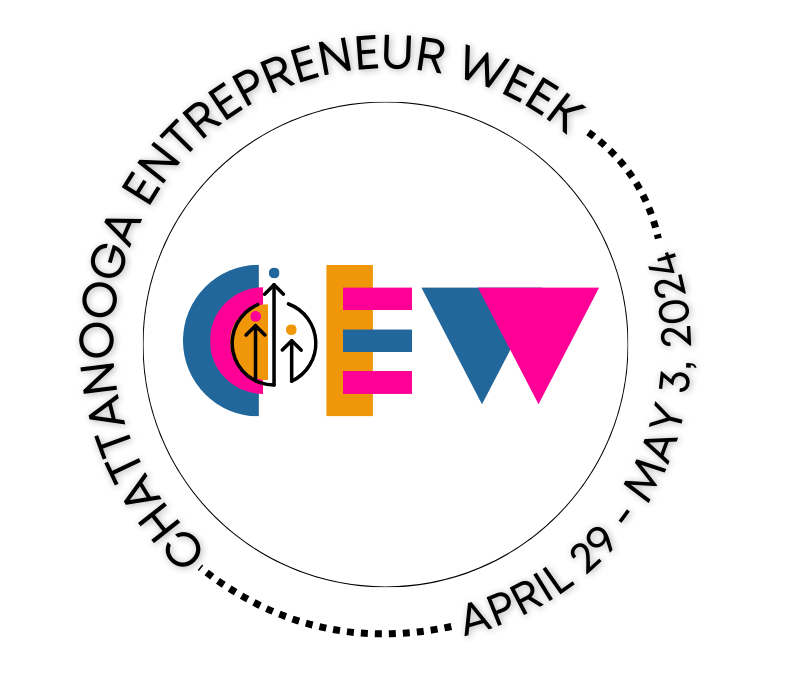
by Cortina Jenelle | Apr 1, 2024 | blog, business, entrepreneurs, imagination
It’s always a win-win when I get to do branding and web design work for a cause that I’m incredibly passionate about. I’m not privvy to have favorite clients butttt, I’m really honored to have been part of the work with the inaugural Chattanooga Entrepreneur Week, produced by Chattanooga Business Resource Collective and happening the week of April 29th to May 3rd, with main events @ Finley Stadium & First Horizon Pavilion.
I fell in love with entrepreneurship at the ripe age of 12 years old.
Working inside of my grandmother’s catering business for years and witnessing her grit, service, abundance, hard work and purpose made me want that for myself, even though I didn’t know it at the time. This woman was able to travel and share her love of cooking with some of the dankest fried catfish plates at festivals, events and gatherings all along the East Coast and often reminded me how risky it was being a Black woman in business from the rural South. At one point, I worked in corporate and in nonprofits and hospitality and sales and customer service and healthcare and social work and tech/IT. Trying…HOPING…that I could get a job, and stay in that job long-term, retire from said job and have a simple, quiet life.
I tried to keep my distance from entrepreneurship. Truly, I did.
But God had other plans. And I’m glad He did.
Entrepreneurship represents so many things for, and to, me now. Maybe the three most important reasons I love entrepreneurship and see it as upward mobility in ANY community are:
✅ It’s one of the best ways to solve our own problems.
✅ It’s one of the best ways to build generational wealth.
✅ It’s the best way to serve and support our neighbors and positively incentivize experts in their craft to keep developing their craft.
All things considered, I’m excited for the upcoming lineup of events at the inaugural Chattanooga Entrepreneur Week, presented by Tennessee Valley Federal Credit Union (TVFCU). The main conference and most events are FREE! Schedule of events and more details are available at www.chabusiness.org/cew.
Branding, graphic design and web design by yours truly 🎯 💫 🚀

by Cortina Jenelle | Jun 21, 2023 | blog, business, entrepreneurs, imagination
The modern workplace is undergoing a significant transformation.
With millennials now forming the majority of the global workforce, the traditional parameters of workspaces are being redefined. In the dynamic world of design and environmentalism, the right setting can be a catalyst for innovation. For the young professional navigating this space, picking the perfect venue for meetings and trainings becomes paramount.A study by Gallup revealed that 43% of millennials envision opportunities to work remotely. With this generational shift, the how and where of professional gatherings are evolving too, emphasizing adaptability, innovation and intentionality.
Millennials, with their distinct values and perspectives, aren’t just looking for a space to convene; they’re seeking venues that resonate with their ethos. This generation is known for championing authenticity, sustainability, and well-being. A venue is more than just a space; it’s an environment that fosters collaboration, ignites creativity, and encapsulates an ethos. For the modern professional, this means a blend of functionality, aesthetics, and sustainable principles. Selecting the right venue becomes an extension of these values, a testament to a commitment to purposeful engagement.
Top 10 Considerations When Selecting a Venue:
- Location Accessibility: Is it easily reachable by public transport or car?
- Tech Infrastructure: High-speed internet, AV facilities, and other tech amenities.
- Sustainability Practices: Does the venue promote eco-friendly measures?
- Space Layout: Open spaces for brainstorming, quiet zones for focused tasks.
- Aesthetic Value: A design that fosters creativity and reflects organizational values.
- Catering and Refreshment Options: Healthy, diverse, and sustainably sourced options.
- Budgetary Fit: Ensuring value for money without compromising on essentials.
- Safety and Security: Adequate measures in place for the safety of attendees.
- Flexibility: Option for rearranging spaces or accommodating special requests.
- Feedback and Reviews: What have previous users said about the venue?
The perfect venue doesn’t just look good; it does good. A venue that incorporates sustainable practices, from energy-saving solutions to waste reduction, resonates with the millennial ethos so this may be important to consider if you’re on the designing side of as a space. Think of the Salesforce Tower in San Francisco, a beacon of eco-friendly architecture, or the Bullitt Center in Seattle, dubbed the “greenest commercial building in the world”, or meeting venues like Proximity Hotel, the USA’s first LEED Platinum Certified hotel. Its management company, Quaintance-Weaver Restaurants & Hotels happened to be the site of my first professional job out of college. These are epitomes of how design and environmentalism can harmoniously coexist. For millennials, these aren’t mere structures but symbols of a progressive future.
As we usher in an era where the line between work and play blurs, where innovation is as much about space as it is about ideas, the onus is on us to make mindful choices. For those seeking to explore potential venues, platforms like Peerspace, Splacer, or even local directories can be invaluable resources.
Remember, whether you’re the person looking for the perfect spot to host your next gathering or the designer of a space for professionals to gather, choosing a venue is no longer just a logistical decision – it’s a statement, a reflection of intent and values. Cheers to forging ahead, building bridges, and laying the foundation for meaningful engagements in spaces that inspire!
Pictured: Common House No. 3, Chattanooga, TN

by Cortina Jenelle | May 24, 2023 | blog, entrepreneurs, facilitation, imagination, liberation
School’s almost out! So, there is no time the present to talk about equity and education.
In the intricate journey of human advancement, the corridors of traditional educational establishments have often echoed uniformity. Yet, there’s a burgeoning movement to champion a more emergent and equitable approach to learning. We can all agree that the year 2020 became a hallmark of rapid transformation. Suddenly, parents were teachers, hall monitors, janitors, lunch ladies, bus drivers and tutors and many school systems scrambled to meet the burgeoning needs of their students. Forced to adapt almost overnight, educational structures began to realize the significance of flexibility and inclusivity. These tumultuous times catalyzed an essential re-evaluation, championing a more emergent and equitable approach to learning. Thus began the new dawn of educational philosophy and a reconstruction period for education as we know it.
Historically, the education system has mirrored societal hierarchies, often entrenching inequalities. But with the civil rights movements and progressive ideologies gaining ground in the 20th century, a push for a more inclusive and adaptive education became evident. Today, this ethos is embraced worldwide, with institutions recognizing the value of diverse thought and fostering environments where every voice matters. At its core, equitable education is about ensuring that every learner’s unique experiences and needs are acknowledged and catered to. Instead of a one-size-fits-all methodology, it celebrates diversity and individual potential. Simplified, it’s the idea that education should be a tailored journey, not a mass-produced product. Students should feel seen, heard, and understood, with the curriculum adapting to them, rather than the other way around.
In this reimagined educational landscape where equity leads, the role of the teacher would have to evolve dramatically. In fact, because of the demands of virtual learning, the role of the teacher already has. Instead of merely imparting information, educators become facilitators and co-learners. They set the stage for exploration and guide the process, but they’re also open to learning from the students. This approach prioritizes mutual respect and encourages learners to take an active role, fostering a community of inquiry and shared discovery. The emergent approach draws inspiration from various philosophies.
The Montessori method, for instance, places children at the center of their own learning journeys, emphasizing hands-on discovery and individualized pacing. The Sudbury model, on the other hand, is based on democratic principles, allowing students significant autonomy in deciding what and how they want to learn. It often involves students participating in administrative decisions, emphasizing respect, freedom, and responsibility. By amalgamating these philosophies, equitable education seeks to create environments where every student is empowered and engaged. And a forest/nature school model facilitates learning in an outdoor setting to teach principles of reciprocity and sustainability.
As we stride into a future characterized by rapid change, it’s imperative to have an education system that champions adaptability, inclusivity, and innovation. Equitable education isn’t just about fairness; it’s about preparing a generation to navigate complexities with empathy and wisdom. So what does this all mean? Only what you want it to. The reimagined philosophy of education doesn’t seem to be a trend, it’s evidence of a necessity that we have been trying to evolve for nearly a century. As we reshape our learning environments, we could also sculpt a brighter, more inclusive future for all.
Photo by Sam Balye on Unsplash

by Cortina Jenelle | Apr 20, 2023 | blog, business, deib, facilitation, imagination
Over the years, I have had conversations with many business and nonprofit leaders as they are in the trenches and seeking to engage the Black, indigenous, persons of color (BIPOC) population as their grants compel them to do. Gaps in engagement and participation in programming by the BIPOC community point to a lack of trust, or more importantly, a lack of relationship with the BIPOC community that the grants are written on behalf of. Engaging authentically is paramount if nonprofit leaders want to engage in a space of empathy and mutual aid as opposed to sympathy and charity.
NURTURE A CONNECTION THROUGH APPRECIATION
For nonprofit leaders aiming to foster a deeper connection with the Black community, a thoughtful and multifaceted approach is necessary. Firstly, it is pivotal to comprehend the historical and cultural context surrounding the Black community. This entails educating oneself about the historical experiences and significant contributions of the Black community both regionally and globally. It is equally important to recognize the nuances and the rich diversity within the Black community, understanding that it is not a monolithic group. Cultivating a deep appreciation for the vibrant cultural heritage while avoiding stereotyping and assumptions is an essential part of this process.
SPARK CONVERSATIONS
Next, embarking on the path of meaningful dialogue is key. This can be facilitated through community meetings where individuals can express their viewpoints and concerns, thereby fostering open conversations. Additionally, establishing channels for community members to offer feedback and suggestions on initiatives will further enhance collaboration. Collaborative efforts, including forming partnerships with existing organizations within the Black community and involving community representatives in planning and decision-making processes, can help in aligning the initiatives more closely with the community’s needs and aspirations.
CELEBRATE CULTURES
Showcase and celebrate the rich diversity within the Black community. Organize cultural events and promote the arts and heritage through various platforms to celebrate diversity. Collaborative celebrations, such as working with community groups to organize events and showcasing stories of individuals making positive impacts, can serve to amplify the sense of community and celebration.
IMPLEMENT + ITERATE
As nonprofit leaders navigate this journey, continuous learning and adaptation should be at the forefront. Reflect regularly on the outcomes of your initiatives, learning and adapting from experiences. Establish a feedback loop with the community to continually refine and enhance your approaches. Be prepared to adapt strategies based on insights gained from engagements and stay responsive to the evolving dynamics and needs within the community.
Photo by Lucie Hošová on Unsplash

by Cortina Jenelle | Mar 21, 2023 | blog, business, creative coach, entrepreneurs, facilitation, imagination, liberation
In the last decade, the professional landscape has witnessed a profound transformation characterized by the rise of remote work modalities. This shift, indeed a significant one, has necessitated a recalibration of team-building strategies and protocols within organizations globally. We have learned how to push based the work-life balance agenda and arrive into a work-life blend.
As someone who often gets called into team-building spaces, I have observed that the integration of remote work within organizational structures has brought forth an enhanced level of flexibility and individual autonomy. Now more than ever, employees are now afforded the opportunity to design their work schedules in a manner that aligns with their personal productivity patterns, fostering a heightened sense of freedom but also, a responsibility and personal ownership over their tasks.
While it’s exciting to have doors open in a global way, this transition has not been without its set of challenges. The detachment inherent in remote work settings has, to a certain extent, diminished the spontaneous interpersonal connections that were the hallmark of traditional office environments. These casual interactions, often undervalued, were vital in nurturing creativity and fostering a collegial atmosphere. Certainly even some of my favorite co-working spaces design around those “water cooler”, “kitchen counter” conversations that could spontaneously spark creativity and collaboration from the tiniest of seeds. The digital medium, despite its many advantages, can sometimes fail to replicate the warmth and camaraderie that physical offices facilitate naturally. So how do we build robust, dynamic teams in a remote environment?
In response to these challenges, the role of team-building has assumed greater significance. The focus has now pivoted towards the development and implementation of virtual team-building initiatives that aim to bridge the gap exacerbated by physical distance. These endeavors, which include virtual coffee breaks, online recreational activities, and remote team retreats, serve as a catalyst in preserving team cohesion and fostering a vibrant organizational culture, even virtually.
It’s not just the physical environment has changed. The massive re-evaluation of leadership communication strategies is underway right along with going remote. Leaders are now tasked with fostering transparency and maintaining regular engagement with team members to ensure alignment of goals and sustained motivation levels. This paradigm shift calls for a strategic reassessment to facilitate a culture that promotes inclusivity and collaborative efforts, even from afar.
In my opinion, the more balanced, autonomous approach and the benefits it could add to personal well-being and happiness means that remote work may be here to stay. It has introduced a dynamic interplay of autonomy and flexibility, while simultaneously compelling teams to innovate in their bonding and collaborative strategies. Certainly this decade from 2020 onwards will be marked by evolutionary growth and adaptation. As facilitators or leaders of any kind, our role is to guide organizations in navigating these changing dynamics, crafting a work culture that resonates with the evolving needs and expectations of the modern workforce. How are you making that work for you?
Photo by Christina @ wocintechchat.com on Unsplash

by Cortina Jenelle | Dec 26, 2022 | blog, creative coach, imagination
Remote work has become a rapidly growing trend in recent years due to the COVID-19 pandemic and advancements in technology. With more people seeking flexible and convenient work arrangements, the demand for remote jobs is increasing. In this article, we will explore the top five remote work jobs that are predicted to grow in the coming years.
- Data Analysts
Data analysis is an important part of many organizations and has become even more vital during the pandemic. With the increasing amount of data being generated, there is a high demand for professionals who can analyze and interpret it. The Bureau of Labor Statistics projects that employment in this field will grow by 11% from 2019 to 2029, faster than the average for all occupations (1). There are so many ways to get paid to use the internet and social media!
- Software Developers
The COVID-19 pandemic has accelerated the need for software development and digital transformation in many industries. Remote work has made it possible for organizations to tap into a larger pool of talent and reduce the costs associated with having a physical office. The Bureau of Labor Statistics projects that employment of software developers will grow by 21% from 2019 to 2029 (1).
- Writers & Transcriptionists
Transcription jobs have become increasingly popular in recent years, offering flexible work options and the opportunity to work from the comfort of one’s own home. Working in a transcription job offers a range of benefits, including flexible work hours, the opportunity to work from home, and the chance to transcribe a variety of audio and video content. Transcription jobs also offer competitive salaries and the potential for career growth, as many companies are looking for individuals with strong language and transcription skills to fill leadership roles. According to a report by Forbes, the demand for transcription services is expected to continue growing, driven by the rise of digital audio and video content, as well as the increasing popularity of podcasting (4). The report also states that the rise of artificial intelligence and speech recognition technology is creating new opportunities in the transcription industry, as companies look for individuals with the skills to transcribe complex and technical audio and video content. Companies are looking for writers to pay right NOW.
- Online Educators & Tutors
The COVID-19 pandemic has forced many schools and universities to close, leading to an increase in online education and tutors that can help provide a well-rounded education. Online educators can now reach students from all over the world, and the demand for their services is expected to grow in the coming years. According to the National Center for Education Statistics, the number of students enrolled in online courses has increased by over 5 million since 2016 (2).
- Live Chat Jobs
Live chat has become a popular customer service channel, offering a convenient and efficient way for businesses to communicate with their customers. With the rise of e-commerce and online shopping, live chat jobs have become a sought-after career option for many individuals. Live chat jobs offer a unique opportunity for individuals looking for a flexible and dynamic career in customer service. With the right skills and qualifications, individuals can excel in this field and enjoy the benefits of working in a fast-paced and challenging environment. As the live chat industry continues to grow, the demand for live chat agents is expected to increase, making it a great career option for those looking to make a difference in the customer service industry. To excel in a live chat job, individuals should possess strong communication and customer service skills. They should also have a solid understanding of the company’s products and services, as well as the ability to navigate different computer systems and software programs. Additionally, live chat agents should have excellent typing and writing skills, as well as the ability to think critically and problem-solve in real-time. Want to give this job a try?
In conclusion, remote work is here to stay, and the demand for professionals in these fields is expected to grow in the coming years. These jobs offer the flexibility and convenience of working from home, as well as the potential for high salaries and job security. With the right skills and experience, individuals can take advantage of this growing trend and build successful careers in these in-demand fields.
Photo by Daniel Thomas on Unsplash
References:
- Bureau of Labor Statistics, U.S. Department of Labor. (2021). Occupational Outlook Handbook. [online] Available at: https://www.bls.gov/ooh/ [Accessed 7 Dec 2022].
- National Center for Education Statistics. (2021). Digest of Education Statistics, 2020 (NCES 2021-094), Chapter 3. Enrollment in postsecondary institutions, by attendance status, sex of student, and control of institution: Fall 2016. [online] Available at: https://nces.ed.gov/programs/digest/d20/tables/dt20_316.20.asp [Accessed 7 Dec. 2022].
- LiveChat. (2022). The State of Live Chat in Customer Service. [online] Available at: https://www.livechat.com/resources/the-state-of-live-chat-in-customer-service/ [Accessed 7 Dec. 2022].
- Forbes. (2022). The Transcription Industry: A Growing Opportunity for Language and Transcription Services. [online] Available at: https://www.forbes.com/sites/forbestechcouncil/2022/01/07/the-transcription-industry-a-growing-opportunity-for-language-and-transcription-services/?sh=41c6d33b4db3 [Accessed 7 Dec. 202w].






